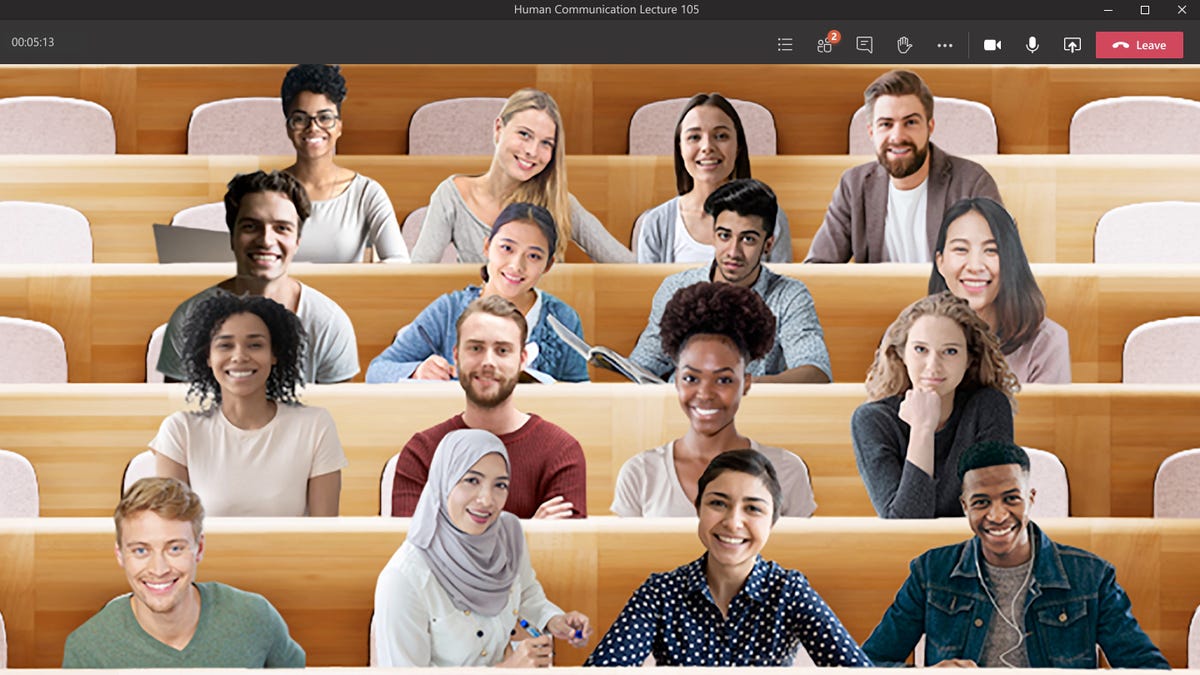Microsoft's new Together mode in Teams puts your video chat in a shared virtual space
In an attempt to make remote meetings less awkward, Microsoft added a shared virtual background concept to Teams. It gave me VR feelings.

Together Mode in Teams, which is also being targeted to handle virtual lectures and classrooms for schools as well as work meetings.
I'm sitting in an auditorium with a bunch of other people. But I'm not really in an auditorium. I'm at home, alone, upstairs, trying a new Microsoft Teams video-conferencing update called Together Mode. The others are video-conferencing in. We're being overlaid in a virtual auditorium background. I see myself sitting next to others who were previously in separate windows. It looks like we're side by side, sharing one giant virtual Zoom background. I sit up straight, trying to look presentable. I feel self-conscious.
Together mode is one of a handful of new Teams features that are aiming to help remote workers and even kids and schools overcome the intense distancing and difficulties of prolonged isolation. Will it work? It's an experiment that Microsoft's Jaron Lanier, a VR pioneer and researcher and collaborator on Together mode, feels could help. Together mode was derived, in part, from VR research on how people interact with avatars. While the overlaid auditorium with us all seated in it seems silly at first, it's based on careful observations, including mirroring your face to match how you're looking around. As you watch your classmates, they may notice you subtly leaning towards them in the room, Lanier explains.
Read more: Here's how to use Together Mode in Microsoft Teams
Since I've been at home for over four months now, I've been in and out of countless work and social Zoom meetings. I've been in Google Hangouts , Webex, FaceTimes, Houseparties. I've met with groups and had briefings in VR. I've also watched my kids in remote school meetings and summer camps, D&D sessions and Roblox parties. My whole world has gone virtual. It's something we've all gotten used to because we've had to. I also notice a lot of people, including my son, dropping his camera feed from meetings. It's hard for him, I think, to feel like he's connecting. I feel lots of fatigue and isolation, too. Will seeing himself in a virtual classroom help at all? I wonder how it'll feel for kids to be aware of themselves, seeing their own faces from a distance. I prefer not to see my own face while chatting.
The Together Mode in Teams can show up to 49 people in a shared space at once, which Lanier feels is around the human factors limit for how people collaborate improvisationally. There are other Teams updates, too: a hand-raising and emoji-creating tool, whiteboard support, Cortana, transcriptions of meetings. But as someone who's been finding myself torn between VR and flat screens as a way to virtually connect, Together Mode is by far the most interesting idea.
Read more: How to customize your Microsoft Teams background
Microsoft's launching its new Teams updates during the pandemic, midstream through a year where many people have been forced to stay at home, and where the outlook for the rest of the year and even 2021 seems to suggest more of the same. I've been wondering when big tech companies were going to update key features on remote conferencing software, and Microsoft just took its first step. It's clearly not a final step, and it's a rushed step brought to the forefront as a way to help with remote work and school. Whether it works, or is the start of something more on the horizon, is unclear, because our whole existence right now is unclear, too.

